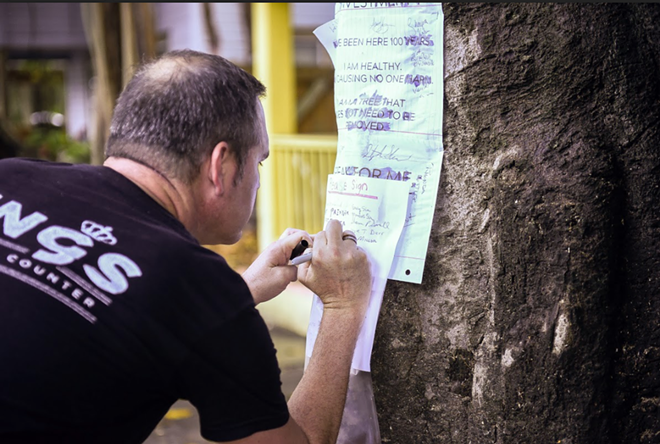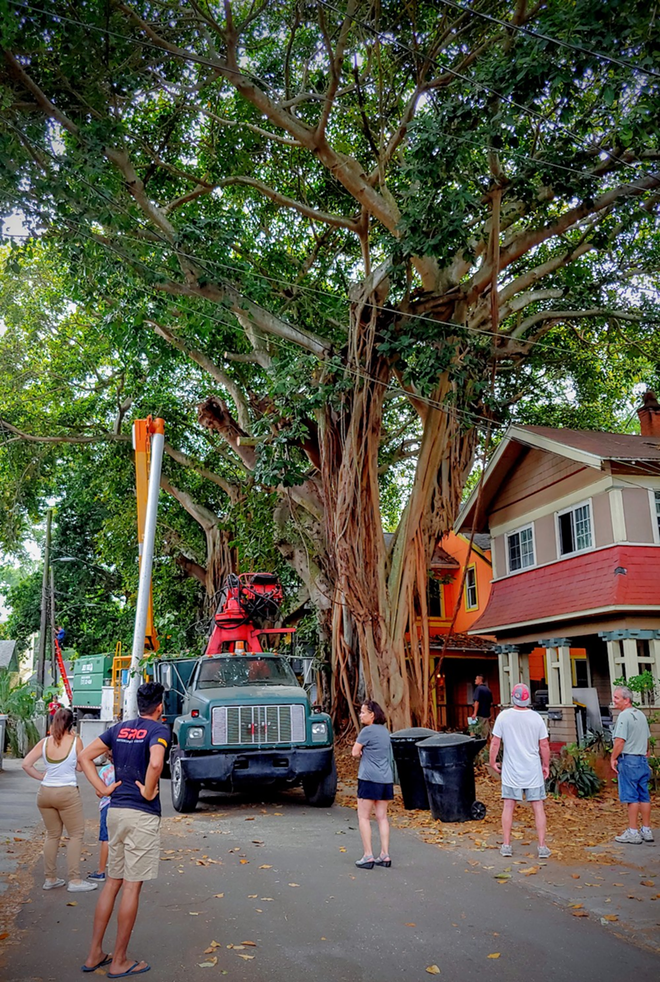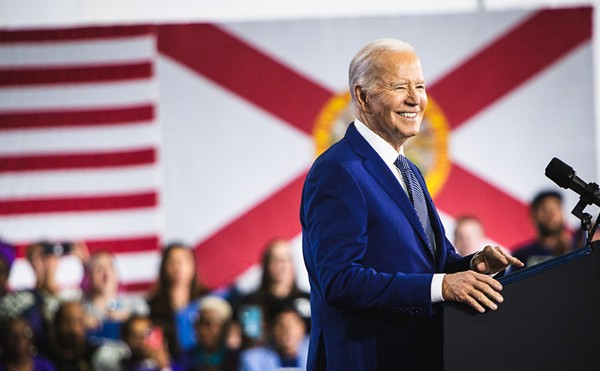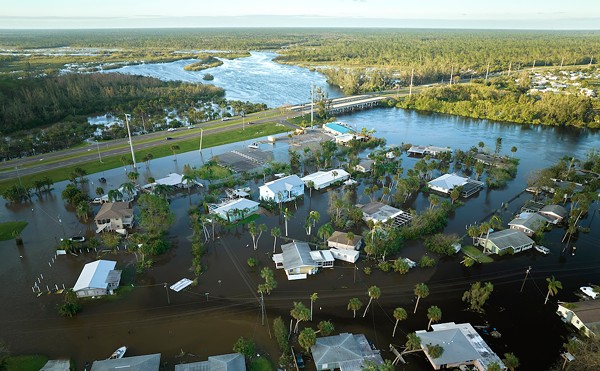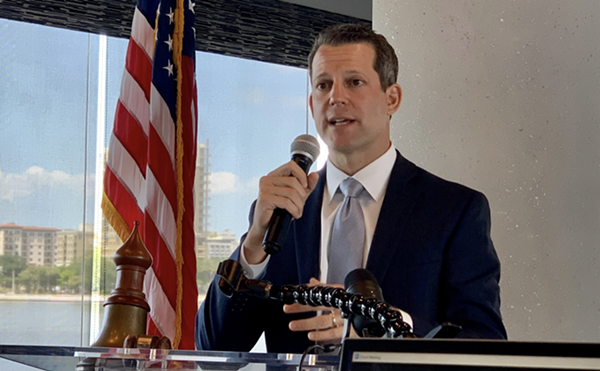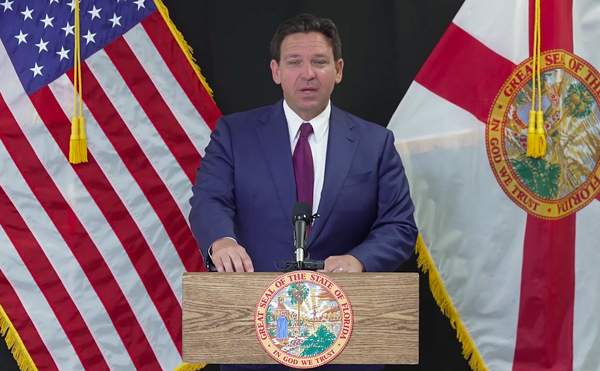There is a town in the heart of Florida where all life seems to live in harmony with its surroundings. The town calls itself St. Petersburg. The town is located in Pinellas County, called “point of pines,” by the Spanish for the pine trees once covering the tiny peninsula. Pinellas County is also known as “Tree City, USA.” Not long ago, this town saw fit to cut down and remove a very old and very beloved banyan tree. The Granville Court banyan as it is known sits squarely in memory for many of the people in the town. The braids and roots and trunk and canopy stayed with the people, even after they left for other towns. Some tried to stop the tree from being cut down, but it was too late. The town said the tree was a danger. An Indigenous activist who came to pray over the tree’s last days was attacked by one of the men in the town hired to cut the tree down
The town did not arrest anyone. The town became silent about the attack, silent about the tree. The street where the banyan tree once stood grew silent, too, because there were no braids and roots and trunk and canopy for the birds and fruit bats and possums to go and make the noises of being alive. The banyan tree is not from this town, it is from a far away place that never cuts down its banyan trees. The people in the town had lived in harmony with this tree for so long, so what changed? And how can the town prevent this from happening again? This is an attempt to understand.
Let’s go back to April of this year, when word spread through the historic Uptown neighborhood Facebook forum that a tree service had begun cutting the Granville Court banyan tree down. At that time, the property where half of the tree sits was recently sold. The new property owners did not yet have permission from the adjacent neighbor to the north, whose property contains the other half of the tree.
Under St. Pete’s Revised Tree Protection Standards, a permit is required to remove a banyan (kinda). The banyan tree is not native to Florida (more on that in a minute) but is considered by St. Pete to be a “signature tree,” a category of non-native trees which St. Pete’s standards describe it as “because of the size, prevalence and history in our community warrant recognition and protection.” Kapoks, jacarandas and royal poincianas also fall into this category. Because it’s a signature tree, the city of St Petersburg was able to stop the Granville banyan removal in April until more information and proper permissions were in order. The town celebrated, this newspaper reported on how the community had saved the tree.
On April 20, one of the owners who initially wanted to cut down the tree told Creative Loafing Tampa Bay that they decided to just prune it under the guidance of the City of St. Petersburg’s Urban Forester Shane Largent.
On Wednesday, July 29, Uptown residents heard chainsaws on the Granville banyan. In the days leading up to El Cheapo Tree Service arriving to begin taking down the tree, information from the City of St. Petersburg and Ed De Paul—a certified arborist and the owner of El Cheapo—said that the tree was indeed sick and needed to come down based on De Paul’s assessment. Determinations by multiple arborists, including the city’s own Largent, had been made that the Granville banyan was beyond saving.
New aerial photos showed more decay and instability than was previously seen in April. A permit was issued by the city; it allowed El Cheapo to remove the Granville banyan. The adjacent property owner, a man who’s lived under the Granville banyan for 20 years, finally signed off on the removal, too.
Indigenous activists from Florida Indigenous Rights and Environmental Equality (FIREE) came out to perform prayer over the tree that afternoon. They burned sage around the fallen limbs, laid hands on the remaining trunk, and asked forgiveness for the men cutting down the tree.
On July 30, as the tree service began the second day of a four-day long process of removing the banyan, this reporter spent over an hour with De Paul walking through the worksite. The damage he pointed out seemed very much decayed, the sawdust at the center of some of the trunk seemed sick. De Paul said he’s spent 30 years as an arborist and that he’s for preservation. He described how this tree had been badly cared for over the years. He was sad and wanted to help.
That afternoon, FIREE spoke with De Paul directly on the phone. He called FIREE to apologize for not knowing “you people considered those trees sacred.” FIREE told De Paul that the group would be back to pray again and speak to press the next morning.
The next morning, things unraveled quickly.
On Friday, July 31, the El Cheapo crew member threatened an Indigenous activist and this reporter with felony charges for crossing a worksite—a worksite that De Paul allowed this reporter to walk all over the day before as the crew worked on the tree. De Paul—along with cop cars from days before—were not on site for the first time in three days. A still-unnamed El Cheapo worker put his hands on the activist Stuart, who went limp and did not fight back. He did what non-violent activists are trained to do when someone gets violent. He said, “don’t put your hands on me, I’m here for prayer.”
This happened to the Indigenous activist just before he, this reporter, and another neighbor moved towards WFLA’s Christine McLarty who was setting up across from the worksite. The physical exchange—which McLarty did not witness firsthand since she arrived just after the incident happened—was unprovoked. It happened in front of this reporter’s eyes. It was steps away and horrifying. The FIREE activist was not there in protest but to pray for the tree, like many others had been on Wednesday, July 29.
This reporter called 911 once she and Stuart and got across the street to WFLA’s McLarty. Another neighbor (the other witness) dialed 911 as well. Concerning the incident, FIREE sent a letter to St. Petersburg Mayor Rick Kriseman on Wednesday, August 5. The organization called for accountability for the event.
That Friday after the incident, St. Petersburg Police’s Public Information Officer Yolanda Fernandez told CL that there were “two very different versions,” from the incident and that El Cheapo workers told police that the Indigenous activist was moving towards workers who were in the midst of taking a limb down, thus putting the activist in harm’s way. Fernandez added that another version of the events paint the El Cheapo worker as the aggressor.
“Nobody was hurt,” Fernandez said, adding that the charge would have been simple battery, a misdemeanor, for which there would have been no arrest—just a notice to appear. “But what they’re going to do is write up a report, and then submit it to the state attorney to determine whether there will be charges to file.”
FIREE’s Sheridan Murphy told CL his group is “pursuing all legal options related to the incident.”
The tree trimming crew finished the removal of the Granville banyan tree on Monday, August 3.
Local certified arborist Johnny Bolender says he gave the owners an assessment in April that he believed he could prune enough to save the banyan. Bolender worked on the same tree after a freeze in 1987 and has led the rehabilitation of the Crescent Lake and Round Lake banyans. He told CL that he never heard back from the owners; after the initial April phone call to CL, those same owners refused to provide comment to CL.
Even if multiple arborists hadn’t agreed the banyan needed removal, even if the city hadn’t issued a permit and the adjacent property owner hadn’t signed off, the tree could’ve been removed and removed legally. That’s in part because while St. Pete might consider its older banyans “signature,” Pinellas County actually classifies ficus as a Category I invasive exotic species. Because banyans reproduced asexually, all it takes is a small clipping for a banyan to root and take over.
Banyans in Florida
Banyans are the largest tree in the world based on canopy coverage. The banyan is India’s native national tree and considered sacred. Because the banyan roots itself aerially and quickly, it's sometimes called “the walking tree.” Its proficient canopy provides crucial shade and cooling in the country’s hot climate.The banyan is where Buddha is believed to have achieved enlightenment. The trees are protected in India, some are three or four acres in size and hundreds of years old.
Florida is the only place in North America where banyans are found. So how the hell did a tree from India get to Florida? In 1925, Harvey Firestone gifted a then-four-foot Ficus benghalensis or “banyan,” to his friend Thomas Edison’s winter home in Fort Myers. Firestone and Edison, along with Henry Ford, had hoped the Banyan’s resin could be turned into commercial rubber inside the Edison and Ford rubber laboratory. The banyan didn’t prove profitable for any of the American industrial magnates but the walking tree walked across Florida from there.
Steve Robinson is the commercial horticulturist at the Pinellas County extension service and the bearer of bad banyan news. The county doesn't require removal of most ficus aka banyans but it does strongly encourage it.
“It has the ability to displace native plants both spatially and chemically,” Robinson said.“It’s like getting rid of a rattlesnake ready to bite you.”
Norm Easey, president of Florida’s ISA (International Society of Arboriculture), said that banyans need a lot of space and a lot of care, above ground and below ground pruning annually if not more often. The older the tree, the less pruning it can take. Basically, don’t plant a tree where it can’t grow—or plan on investing in its upkeep.
“We have a saying in arboriculture: ‘Right tree, right place,’” Easey told CL. “That means put the right species in the right place, and both will coexist for a long time. But if you screw up that equation, one of them is going to suffer.”
Suffer indeed. It’s worth noting that citrus was once brought here by the Spanish and is now considered so Floridian that it’s on license plates and state signs. Who gets to decide when something naturalizes and when it becomes a danger? This question is further complicated by the passing of Florida’s Private Property Protection Act last year. Also known as HB 1159, the ordinance passed by Republican Representative Mike LaRosa (and co-introduced by Blackface-wearing elected official Anthony Sabatini) allows for private property owners to supersede local protections specifically in tree removals. Pensacola is challenging the language in court now following the possible wrongful removal of a 200-year-old live oak tree by a certified (kinda) arborist.
This story started with one banyan tree and all the people who’ve loved it. That heartache rooted from above to the ground of accepting this tree was sick, that maybe we hadn’t taken care of it while in awe. But then, like a banyan, the story spiraled and became about what a man did to an Indigenous man who was trying to pray for this tree and the elders buried in the ground beneath us all. Each day felt like a new trunk crashing to the ground, like a canopy of contradictions between what’s sacred and what’s invasive. The Granville banyan’s been gone for two weeks now, but its roots have spread and the tree is “walking,” again. The good news is these trees like to grow and grow fast, the harder news is that protecting and caring for them and those that fight in their honor will continue to be a climb.
Support local journalism in these crazy days. Our small but mighty team is working tirelessly to bring you up to the minute news on how Coronavirus is affecting Tampa and surrounding areas. Please consider making a one time or monthly donation to help support our staff. Every little bit helps.
Subscribe to our newsletter and follow @cl_tampabay on Twitter.


